
Deforestation or forest clearance is the removal of a forest or stand of trees from land that is then converted to non-forest use. Deforestation can involve conversion of forest land to farms, ranches, or urban use. The most concentrated deforestation occurs in tropical rainforests. About 31% of Earth's land surface is covered by forests at present. This is one-third less than the forest cover before the expansion of agriculture, with half of that loss occurring in the last century. Between 15 million to 18 million hectares of forest, an area the size of Bangladesh, are destroyed every year. On average 2,400 trees are cut down each minute.

The Amazon rainforest, also called Amazon jungle or Amazonia, is a moist broadleaf tropical rainforest in the Amazon biome that covers most of the Amazon basin of South America. This basin encompasses 7,000,000 km2 (2,700,000 sq mi), of which 5,500,000 km2 (2,100,000 sq mi) are covered by the rainforest. This region includes territory belonging to nine nations and 3,344 formally acknowledged indigenous territories.

The National Institute of Amazonian Research is a public educational and research institution headquartered in Manaus, Brazil. It was founded in 1952, with the purpose of furthering scientific knowledge of the Brazilian Amazon Region. Most of INPA's research focuses on tropical forest management, ecology, molecular ecology, zoology, botany, tropical agriculture and tropical pisciculture. The institution also maintains important vertebrate, invertebrate, and vascular plants research collections.
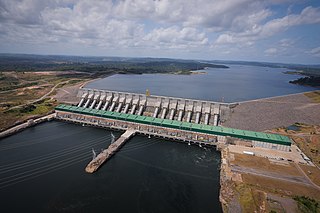
The Belo Monte Dam is a hydroelectric dam complex on the northern part of the Xingu River in the state of Pará, Brazil. After its completion, with the installation of its 18th turbine, in November 2019, the installed capacity of the dam complex is 11,233 megawatts (MW), which makes it the second largest hydroelectric dam complex in Brazil and the fifth largest in the world by installed capacity, behind the Three Gorges Dam, Baihetan Dam and the Xiluodu Dam in China and the Brazilian-Paraguayan Itaipu Dam. Considering the oscillations of flow river, guaranteed minimum capacity generation from the Belo Monte Dam would measure 4,571 MW, 39% of its maximum capacity.
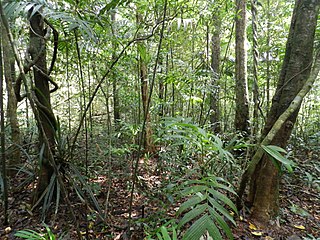
Building blocks for tropical rainforest conservation include ecotourism and rehabilitation. Reforestation and restoration are common practices in certain areas to try to increase tropical rainforest density. By communicating with the local people living in, and around, the rainforest, conservationists can learn more about what might allow them to best focus their efforts. Rainforests are globally important to sustainability and preservation of biodiversity. Although they may vary in location and inhabited species of plants and animals, they remain important worldwide for their abundance of natural resources and for the ecosystem services. It is important to take into consideration the differing species and the biodiversity that exists across different rainforest types in order to accurately implement methods of conservation.
Darrell Addison Posey was an American anthropologist and biologist who vitalized the study of traditional knowledge of indigenous and folk populations in Brazil and other countries. He called his approach ethnobiology and combined research with respect for other cultures, especially indigenous intellectual property rights.

The Balbina Dam is a hydroelectric dam and power station on the Uatumã River in the Amazon Rainforest, Brazil. The location is under the municipality of Presidente Figueiredo jurisdiction, in the state of Amazonas.

Brazil once had the highest deforestation rate in the world and in 2005 still had the largest area of forest removed annually. Since 1970, over 700,000 square kilometres (270,000 sq mi) of the Amazon rainforest have been destroyed. In 2001, the Amazon was approximately 5,400,000 square kilometres (2,100,000 sq mi), which is only 87% of the Amazon's original size. According to official data, about 729,000 km² have already been deforested in the Amazon biome, which corresponds to 17% of the total. 300,000 km² have been deforested in the last 20 years.
The Uatumã River is a river flowing through the state of Amazonas in Brazil. It is a northern tributary of the Amazon River, and known for its extensive peacock bass population. It is a blackwater river.
Environmental issues in Brazil include deforestation, illegal wildlife trade, illegal poaching, air, land degradation, and water pollution caused by mining activities, wetland degradation, pesticide use and severe oil spills, among others. As the home to approximately 13% of all known species, Brazil has one of the most diverse collections of flora and fauna on the planet. Impacts from agriculture and industrialization in the country threaten this biodiversity.

The Amazon rainforest, spanning an area of 3,000,000 km2, is the world's largest rainforest. It encompasses the largest and most biodiverse tropical rainforest on the planet, representing over half of all rainforests. The Amazon region includes the territories of nine nations, with Brazil containing the majority (60%), followed by Peru (13%), Colombia (10%), and smaller portions in Venezuela, Ecuador, Bolivia, Guyana, Suriname, and French Guiana.

Even though progress has been made in conserving Brazil’s landscapes, the country still faces serious threats due to its historical land use. Amazonian forests substantially influence regional and global climates and deforesting this region is both a regional and global driver of climate change due to the high amounts of deforestation and habitat fragmentation that have occurred this region.
Pia Parolin is a biologist and tropical ecologist, council member of the Society for Tropical Ecology (gtö) and the Association of Tropical Biology and Conservation (ATBC).

William F. Laurance, also known as Bill Laurance, is Distinguished Research Professor at James Cook University, Australia and has been elected as a Fellow of the Australian Academy of Science. He has received an Australian Laureate Fellowship from the Australian Research Council. He held the Prince Bernhard Chair for International Nature Conservation at Utrecht University, Netherlands from 2010 to 2014.

The Amazon Tall Tower Observatory or ATTO is a scientific research facility in the Amazon rainforest of Brazil. This includes a 325-metre-tall (1,066 ft) tower that extends far above the forest canopy and two 80-metre (260 ft) towers that allow researchers to collect samples from the soil surface to above the forest canopy. Additionally, there are climate-controlled containers for laboratory equipment and an office, a base camp and nearby sites for studying vegetation and soil processes. The tall research tower is one metre taller than the Eiffel Tower and is currently the tallest structure in South America. All towers are equipped with a broad range of instruments to measure chemical and physical properties of the atmosphere, such as greenhouse gas concentrations, aerosols and meteorological data.
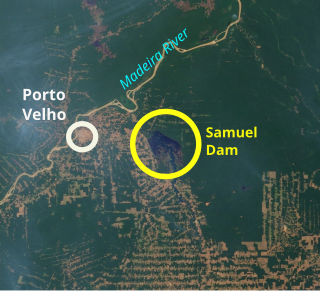
The Samuel Hydroelectric Dam is a 216 MW hydroelectric dam near Porto Velho, Rondônia, Brazil. The project was controversial since it had a major environmental impact and during operations released more greenhouse gases than a comparable oil-fuelled plant.
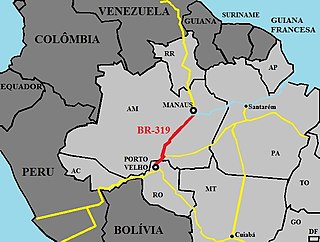
BR-319 is an 870-kilometre (540 mi) federal highway that links Manaus, Amazonas to Porto Velho, Rondônia. The highway runs through a pristine part of the Amazon rainforest. It was opened by the military government in 1973 but soon deteriorated, and by 1988 was impassible. In 2008 work began to repair the highway, which will provide an alternative to boat travel along the Madeira River or flying between Manaus and Porto Velho. Protected areas have been created along the route in an effort to prevent deforestation when BR-319 is reopened, a serious concern given the devastation caused elsewhere by highways such as BR-364. As of mid-2016 paving of the middle section of the highway had yet to be approved. Construction permits will depend on measures to prevent future damage to the forest.

Imazon is a non-profit organisation based in Belém, Pará, Brazil, that is dedicated to conserving the Amazon rainforest. It has published many reports on aspects of conserving the Amazon environment, has had a significant impact on environmental policy in Brazil, and has developed tools through which deforestation may be viewed online.
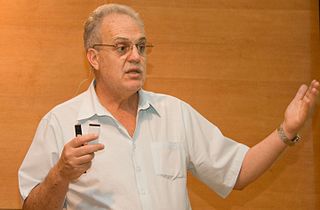
Carlos Afonso Nobre is a Brazilian scientist and meteorologist who is mainly highlighted in global warming-related studies. Nobre spearheaded the multi-disciplinary, multinational Large-Scale Biosphere-Atmosphere Experiment in Amazonia, a program noted to have “revolutionized understanding of the Amazon rainforest and its role in the Earth system.”

Climate change in Brazil is mainly the climate of Brazil getting hotter and drier. The greenhouse effect of excess carbon dioxide and methane emissions makes the Amazon rainforest hotter and drier, resulting in more wildfires in Brazil. Parts of the rainforest risk becoming savanna.
















